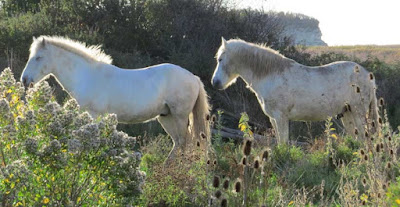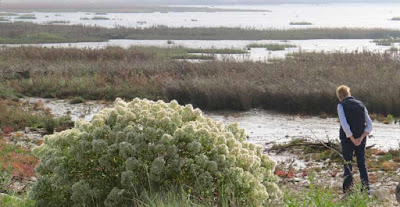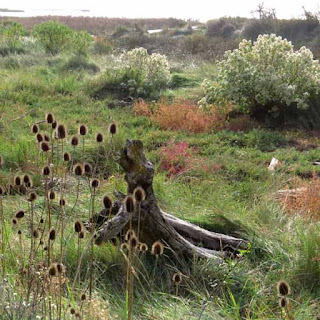"I am a little world made cunningly
Of elements, and an angelic sprite" - John Donne
 |
| Horses enjoying the cool bright mornings |
Now that so much of our garden is in shadow during the day, we find ourselves taking more shore walks, savouring the crisp air and squinting through bright sunshine to get a glimpse of migrating birds along the estuary.
 |
| Cranes... en route to Spain and beyond |
For a few days we're treated to the unmistakable 'call of the wild' as flocks of cranes arrive from north-east France, drawn to the silvery glint of the Gironde Estuary marking their pathway down south.
Sometimes it's just a few birds and, if we're lucky, they might decide to make an overnight stop near our neighbour's lake...
On other occasions, the sky can be wreathed with skeins of more than a hundred calling cranes. It's an unforgettable cry which makes the hairs stand up on your neck and has caused Christina to almost screech to a halt if she happens to hear them whilst driving!
Recently we've noticed that lapwings have begun gathering again in the fields after a summer break elsewhere.
We went out early the other morning and disturbed a flock of about fifty sitting quietly amongst the reddish tufts of samphire which spreads all over the nearby salt marsh.
I gather this is edible samphire, also known as glasswort from the time when it was used in the production of soda glass.
This type of samphire (Salicornia europaea) turns deep red in autumn - the redder its colour, the more salt there is in the water apparently - and it's certainly noticeable in bright sunlight, transforming the marais from a green prairie into something more like an informal garden.
It's an exciting area to explore on a windy day when light dances off the standing pools of water and feathery reed heads.
Lapwings and other shore birds take wing in fright as you approach and their cries can be heard all along the shoreline.
The other, non-edible, type of samphire is Crithmum maritimum, an umbellifer from the Mediterranean which grows in crevices between the boulders lining the coast.
This also produces vivid florets in autumn and gives the impression of a well planted rock garden - complete with admiring lizard in this case!
Sometimes it's just a few birds and, if we're lucky, they might decide to make an overnight stop near our neighbour's lake...
On other occasions, the sky can be wreathed with skeins of more than a hundred calling cranes. It's an unforgettable cry which makes the hairs stand up on your neck and has caused Christina to almost screech to a halt if she happens to hear them whilst driving!
 |
| Lapwings on the marais |
We went out early the other morning and disturbed a flock of about fifty sitting quietly amongst the reddish tufts of samphire which spreads all over the nearby salt marsh.
I gather this is edible samphire, also known as glasswort from the time when it was used in the production of soda glass.
 |
| Salicornia europaea |
This type of samphire (Salicornia europaea) turns deep red in autumn - the redder its colour, the more salt there is in the water apparently - and it's certainly noticeable in bright sunlight, transforming the marais from a green prairie into something more like an informal garden.
It's an exciting area to explore on a windy day when light dances off the standing pools of water and feathery reed heads.
Lapwings and other shore birds take wing in fright as you approach and their cries can be heard all along the shoreline.
 |
| Crithmum maritimum |
This also produces vivid florets in autumn and gives the impression of a well planted rock garden - complete with admiring lizard in this case!
 |
| Marsh samphire submerged at high tide |
Elsewhere, the effect of a marais garden is enhanced by stands of driftwood washed up after a winter storm and left to weather in the sun.
We used to collect the more artistic pieces and bring them home to decorate our driveway - the cat enjoys sharpening his claws on these stumps, but it turns out they also attract groups of large woodland ants so we've stopped doing that now!
 |
| Aster tripolium or Tripolium pannonicum |
Another common sight at this time of year is the sea aster (Tripolium pannonicum) which is also salt tolerant and grows in marshland and on the edge of brackish ponds.
Again, its red stems stand out from a watery background and its fluffy seedheads drift lazily on the breeze.
For years we noticed some particularly attractive shrubs in the salt marsh which produce masses of white blooms in autumn, followed by seeds like thistledown. We never knew what this was called until searching through photographs on Google Images...
 |
| Baccharis halimifolia Sea Myrtle or Cotton Seed Tree |
Baccharis is known by many names... Tree Groundsel or the much more apt 'Silverling' which conveys something of its graceful, light reflecting quality.
 |
| Baccharis halimifolia Silvery seedheads next to a tamarisk plant |
Being salt-tolerant even in standing water, they've been used to stabilise the shore in many areas and put on a stunning display in Autumn.
 |
| A meditative stroll through Nature's garden |
 |
| Yucca filamentosa |
Another introduction from the south-west US is the popular Yucca filamentosa, producing statuesque creamy blooms from late summer.
This is a plant which loves sand and looks best on the shore or grown in scrub where its spiky leaves aren't likely to attack the poor gardener.
Yuccas can appear quite inoffensive when small, looking pristine in a pot at the garden centre; but inevitably the spikes become more lethal as it develops.
Its leathery leaves are hard to cut off when they are damaged or become shrivelled with age. Once established, you'll probably never get it out of your garden because the roots go deep and will keep producing new stems once the original is removed. Just enjoy it in the wild!
This is a plant which loves sand and looks best on the shore or grown in scrub where its spiky leaves aren't likely to attack the poor gardener.
Yuccas can appear quite inoffensive when small, looking pristine in a pot at the garden centre; but inevitably the spikes become more lethal as it develops.
Its leathery leaves are hard to cut off when they are damaged or become shrivelled with age. Once established, you'll probably never get it out of your garden because the roots go deep and will keep producing new stems once the original is removed. Just enjoy it in the wild!
 |
| Salt marsh at Les Monards |

You're living in paradise.
ReplyDeleteWell we think so but of course I try to reflect the best of it through the seasons. Nearly all pics are mine, mostly taken on a Canon SX50 HS - not a digital SLR but light and easy to use.
Delete